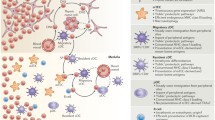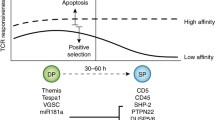Abstract
T cells orchestrate adaptive immune responses upon activation. T cell activation requires sufficiently strong binding of T cell receptors on their surface to short peptides derived from foreign proteins bound to protein products of the major histocompatibility (MHC) gene products, which are displayed on the surface of antigen presenting cells. T cells can also interact with peptide-MHC complexes, where the peptide is derived from host (self) proteins. A diverse repertoire of relatively self-tolerant T cell receptors is selected in the thymus. We study a model, computationally and analytically, to describe how thymic selection shapes the repertoire of T cell receptors, such that T cell receptor recognition of pathogenic peptides is both specific and degenerate. We also discuss the escape probability of autoimmune T cells from the thymus.
Similar content being viewed by others
References
Bhalerao, J., Bowcock, A.M.: The genetics of psoriasis: a complex disorder of the skin and immune system. Hum. Mol. Genet. 7, 1537–1545 (1998)
Borghans, J.A., Noest, A.J., De Boer, R.J.: Thymic selection does not limit the individual MHC diversity. Eur. J. Immunol. 33, 3353–3358 (2003)
Bousso, P., Bhakta, N.R., Lewis, R.S., Robey, E.: Dynamics of thymocyte-stromal cell interactions visualized by two-photon microscopy. Science 296, 1876–1880 (2002)
Chao, D.L., Davenport, M.P., Forrest, S., Perelson, A.S.: The effects of thymic selection on the range of T cell cross-reactivity. Eur. J. Immunol. 35, 3452–3459 (2005)
Chessman, D., et al.: Human leukocyte antigen class I-restricted activation of CD8+ T cells provides the immunogenetic basis of a systemic drug hypersensitivity. Immunity 28, 822–832 (2008)
Daniels, M.A., et al.: Thymic selection threshold defined by compartmentalization of Ras/MAPK signalling. Nature 444, 724–729 (2006)
Deeks, S.G., Walker, B.D.: Human immunodeficiency virus controllers: mechanisms of durable virus control in the absence of antiretroviral therapy. Immunity 27, 406–416 (2007)
Detours, V., Perelson, A.S.: Explaining high alloreactivity as a quantitative consequence of affinity-driven thymocyte selection. Proc. Natl. Acad. Sci. USA 96, 5153–5158 (1999)
Detours, V., Mehr, R., Perelson, A.S.: A quantitative theory of affinity-driven T cell repertoire selection. J. Theor. Biol. 200, 389–403 (1999)
Eisen, H.N., Chakraborty, A.K.: Evolving concepts of specificity in immune reactions. Proc. Natl. Acad. Sci. USA 107, 22373–22380 (2010)
Flicek, P., et al.: Ensembl 2008. Nucleic Acids Res. 36, D707–D714 (2008)
Hogquist, K.A., Baldwin, T.A., Jameson, S.C.: Central tolerance: learning self-control in the thymus. Nat. Rev. Immunol. 5, 772–782 (2005)
Huseby, E.S., et al.: How the T cell repertoire becomes peptide and MHC specific. Cell 122, 247–260 (2005)
Huseby, E.S., Crawford, F., White, J., Marrack, P., Kappler, J.W.: Interface-disrupting amino acids establish specificity between T cell receptors and complexes of major histocompatibility complex and peptide. Nat. Immunol. 7, 1191–1199 (2006)
Janeway, C.: Immunobiology: The Immune System in Health and Disease, 6th edn. Garland, New York (2005)
Kardar, M.: Phase transitions in new solvable Hamiltonians by a Hamiltonian minimization. Phys. Rev. Lett. 51, 523–526 (1983)
Košmrlj, A., Jha, A.K., Huseby, E.S., Kardar, M., Chakraborty, A.K.: How the thymus designs antigen-specific and self-tolerant T cell receptor sequences. Proc. Natl. Acad. Sci. USA 105, 16671–16676 (2008)
Košmrlj, A., Chakraborty, A.K., Kardar, M., Shakhnovich, E.I.: Thymic selection of T-cell receptors as an extreme value problem. Phys. Rev. Lett. 103, 068103 (2009)
Košmrlj, A., et al.: Effects of thymic selection of the T-cell repertoire on HLA class I-associated control of HIV infection. Nature 465, 350–354 (2010)
Migueles, S.A., et al.: HLA B*5701 is highly associated with restriction of virus replication in a subgroup of HIV-infected long term nonprogressors. Proc. Natl. Acad. Sci. USA 97, 2709–2714 (2000)
Miyazawa, S., Jernigan, R.L.: Residue-residue potentials with a favorable contact pair term and an unfavorable high packing density term, for simulation and threading. J. Mol. Biol. 256, 623–644 (1996)
Moszer, I., Glaser, P., Danchin, A.: Subtilist: a relational database for the Bacillus subtilis genome. Microbiology 141(Pt 2), 261–268 (1995)
Naeher, D., et al.: A constant affinity threshold for T cell tolerance. J. Exp. Med. 204, 2553–2559 (2007)
Park, J.M., Deem, M.W.: Correlations in the T-cell response to altered peptide ligands. Phys. A, Stat. Mech. Appl. 341, 455–470 (2004)
Scherer, A., Noest, A., de Boer, R.J.: Activation-threshold tuning in an affinity model for the T-cell repertoire. Proc. Biol. Sci. 271, 609–616 (2004)
Siggs, O.M., Makaroff, L.E., Liston, A.: The why and how of thymocyte negative selection. Curr. Opin. Immunol. 18, 175–183 (2006)
Unanue, E.R.: Antigen-presenting function of the macrophage. Annu. Rev. Immunol. 2, 395–428 (1984)
von Boehmer, H., et al.: Thymic selection revisited: how essential is it? Immunol. Rev. 191, 62–78 (2003)
Werlen, G., Hausmann, B., Naeher, D., Palmer, E.: Signaling life and death in the thymus: timing is everything. Science 299, 1859–1863 (2003)
Yang, M., Park, J.M., Deem, M.W.: Evolutionary design in biological physics and materials science. Lect. Notes Phys. 704, 541–562 (2006)
Zhou, H., Deem, M.W.: Sculpting the immunological response to dengue fever by polytopic vaccination. Vaccine 24, 2451–2459 (2006)
Author information
Authors and Affiliations
Corresponding authors
Rights and permissions
About this article
Cite this article
Košmrlj, A., Kardar, M. & Chakraborty, A.K. The Influence of T Cell Development on Pathogen Specificity and Autoreactivity. J Stat Phys 149, 203–219 (2012). https://doi.org/10.1007/s10955-011-0403-8
Received:
Accepted:
Published:
Issue Date:
DOI: https://doi.org/10.1007/s10955-011-0403-8




